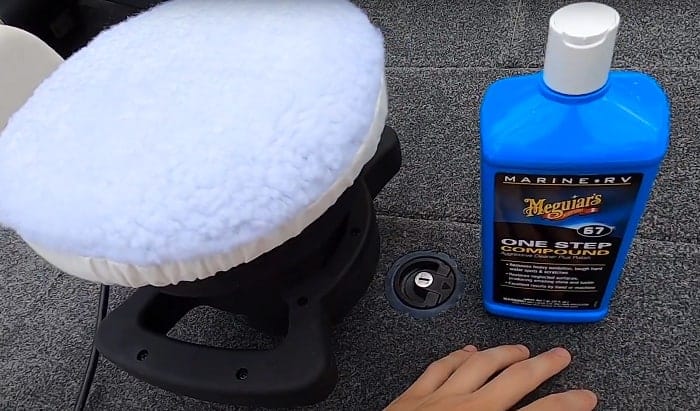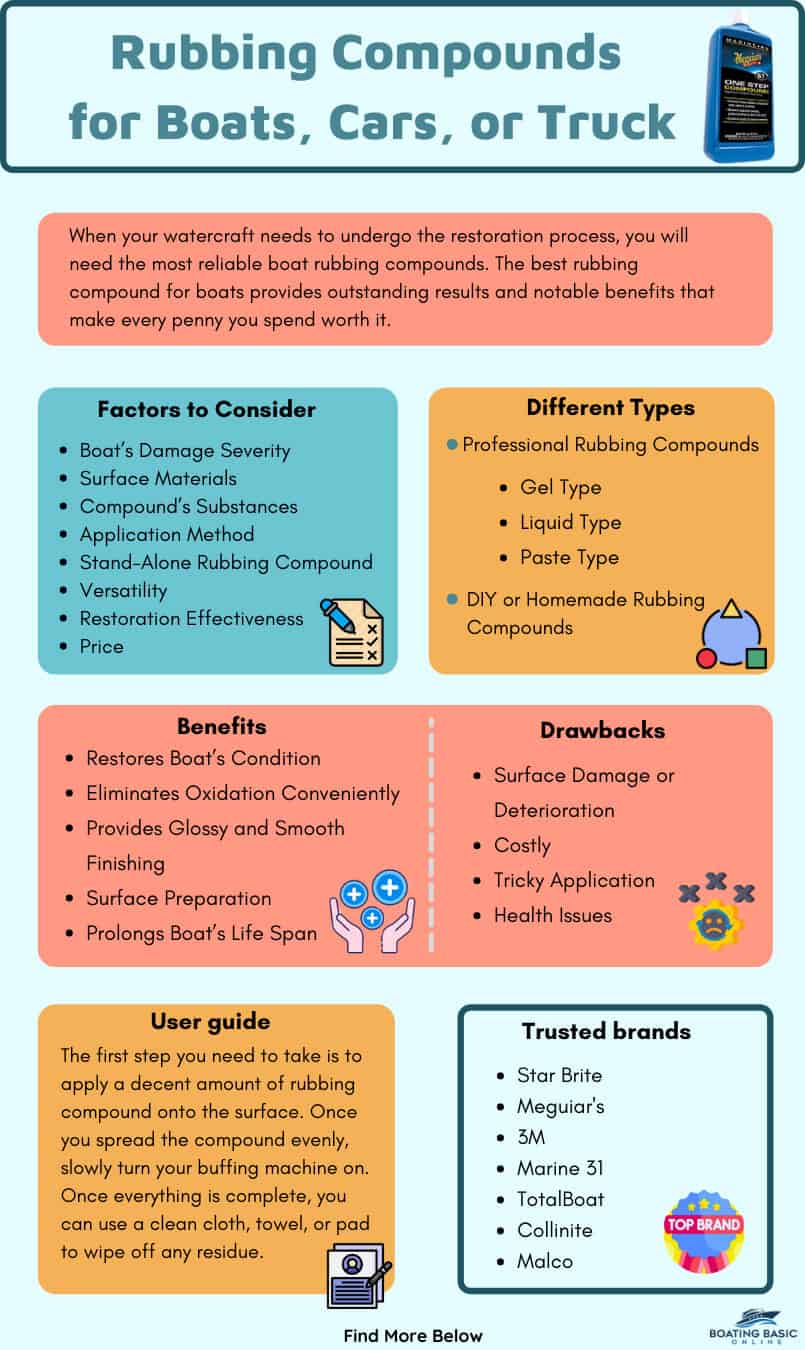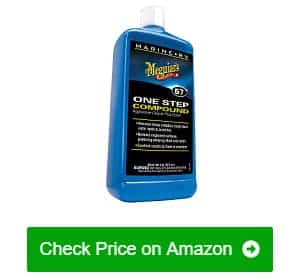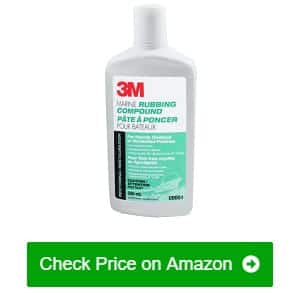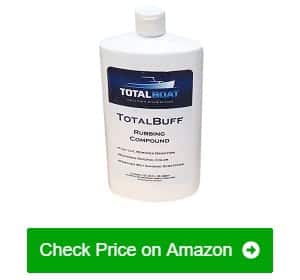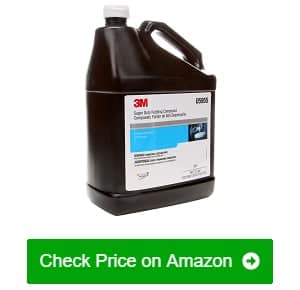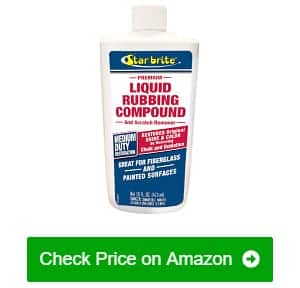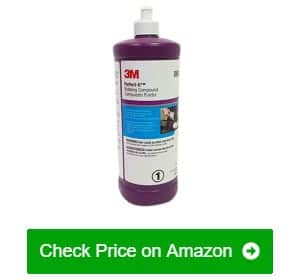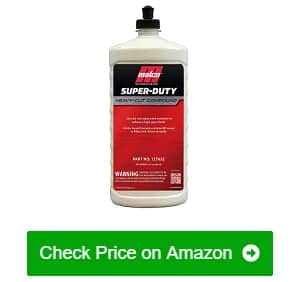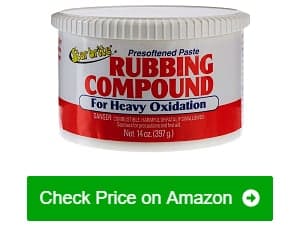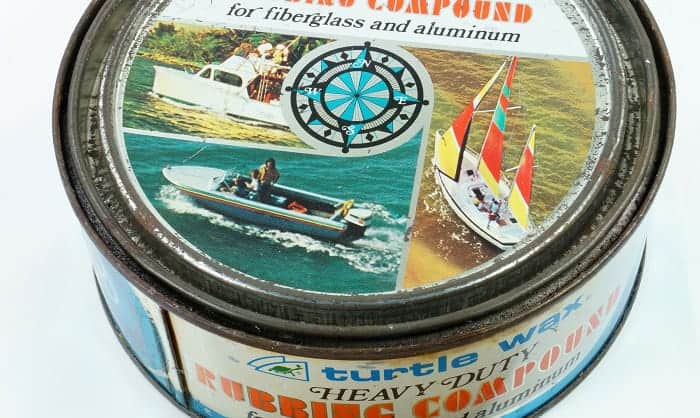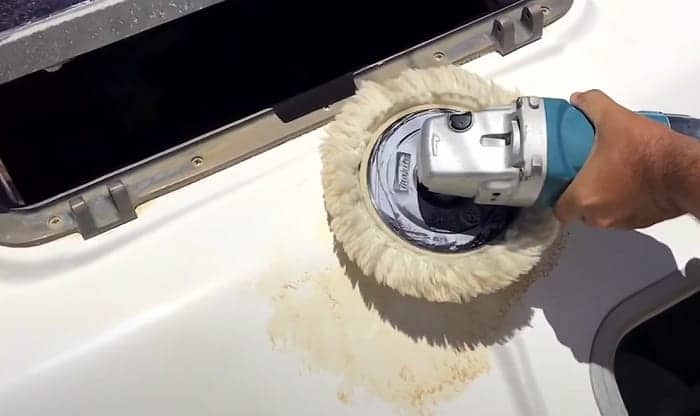When your watercraft needs to undergo the restoration process, you will need the most reliable boat rubbing compounds. The best rubbing compound for boats provides outstanding results and notable benefits that make every penny you spend worth it.
However, it gets difficult to choose from all the potential solutions offered by different manufacturers. Beginners and even veteran boaters face this problem. So, here are some of the pointers to look for while selecting a rubbing compound for boats:
- The Severity of the Boat’s Defects: You should be able to determine if your boat’s damage requires light-duty, medium-duty, or heavy-duty restorers. This way, you can select the most appropriate solution based on the damage’s severity.
- Ease of Application: To obtain the best results, you will need to work with rubbing compounds that are convenient and hassle-free. Application by hand or machine is preferable. You should also choose a compound that allows longer buffing cycles.
- Restoration Effectiveness: If you want to use a rubbing compound, then you should make sure that it removes oxidation, scratches, and other marine stains effectively. Restoring your boat’s surface is the primary goal, but you also have to consider if the solution gives a glossy and smooth finish for professional-like results.
We have filtered countless rubbing compounds in the market according to various features, such as price, treatment compatibility, and functionality. You’ll be able to learn more about these factors and other details in our complete “Buying Guide” for the most suitable rubbing compounds that you should use for your boats.
- Straightforward usage and application
- Restores the color and surface condition
- Delivers incredible luster
- Can be applied by hand or machine
- Provides glossy finishing
- Solution doesn’t dry up quickly
- Versatile and fast-cutting compound
- Revives color and surface condition
- Easy to apply
Table of Contents
Best Rubbing Compound for Boats Reviews
1. Meguiar’s M6732 One Step Compound
Look nowhere else if you are searching for a solution that professionals approve of. Think product right here, is one of the best boat compounds because it guarantees maximum effectiveness in restoring and polishing your marine vessels and even RVs.
A desirable feature of this one-step compound is its straightforward usage and application. All you need to do is apply the formula, using a terry cloth, onto the surface that is cool to touch. Buff the surface with overlapping motions until it is nearly dry. Then, wipe it off with a clean cloth. What’s great is that you can apply this by hand or buffing machine. You can also pair it with Meguiar’s cutting pad and microfiber towel to achieve outstanding outcomes.
I am fond of this compound as it eliminates severe oxidation, water spots, and scratches. I had a heavily oxidized boat, and I’ve tried different solutions, but nothing has given me the results I wanted, except for this. Tough stains are not a problem when you have this with you.
While cleaning is its primary purpose, it also restores the color and the boat’s surface condition. My boat looks new again with vibrant color after the entire process. Plus, this product delivers incredible luster as it cuts through your boat’s surface defects. I like that it can be applied to fiberglass and gel coat surfaces.
- Straightforward usage and application
- Eliminates severe oxidation, water spots, and scratches
- Restores the color and the boat’s surface condition
- Delivers incredible luster
- Can be applied to fiberglass and gel coat surfaces
- May require some elbow grease
2. 3M 09004 Marine Rubbing Compound
I found this solution as I was reading some 3M marine rubbing compound reviews. I was a bit skeptical of this, but thankfully, its features and overall performance lived up to my expectations. With this compound, you can expect the best and most professional-like restoration process.
What catches my attention is that this compound can be applied by hand or machine. I used a clean cloth to put the solution onto the surface. The trick in using your hand is to rub the surface aggressively while maintaining short strokes. This allows you to eliminate unwanted stains quickly. Similarly, light to medium pressure is enough if you are using a machine.
My boat had rust that I cannot eliminate even after using several products, including homemade removers. Now, what I love the most about this compound is that it removes mineral deposits, scratches, and heavy oxidation. Using this was one of the best decisions I made regarding boat care and maintenance.
What’s better is that it provides glossy finishing once you complete the entire routine. I can even see my reflection with just one application. Furthermore, the solution doesn’t dry up quickly, allowing you to work on the surface comfortably with little to no mess. I am also fond of this compound as it is safe to use on painted and gel-coated surfaces.
- Can be applied by hand or machine
- Removes mineral deposits, scratches, and heavy oxidation
- Provides glossy finishing
- Solution doesn’t dry up quickly
- Safe to use on painted and gel coated surfaces
- Need a little bit of elbow grease
As a takeaway, this gel coat restorer is the perfect investment for every boat owner who wants to revive a severely oxidized surface. Not to mention, it leaves a mirror-like finish on surfaces, but please note that slight elbow greasing may occur.
3. TotalBoat TotalBuff Rubbing Compound
Functions similarly to the West Marine Rubbing Compound, this is among the good products available in the market today. It has a number of commendable features that can surpass your expectations.
The first thing that I like about this is that it is easy to apply by hand or a buffing machine. All you need to do is apply a decent amount onto the surface and buff it when the solution forms into a haze. For best results, I recommend using a buffer while working on the surface patiently. Additionally, working on small areas at a time is the best way to achieve uniform outcomes.
What I love the most about this product is that it eradicates wet sanding scratches and heavy oxidation. I sometimes get carried away by wet sanding my boat’s hull, causing problematic marks on my boat’s surfaces. Fortunately, this compound works exceptionally regarding this aspect. It revives the boat’s color and surface condition as well.
Undoubtedly it is worth every penny as it is designed as a versatile and fast-cutting compound. You can use this not only for boats but also for cars, RVs, trailers, and trucks. Apart from that, it can be used on fiberglass, gel coats, and painted surfaces. Surely, having a one-for-all compound is an excellent investment for every boat owner.
- Easy to apply by hand or buffing machine
- Eradicates wet sanding scratches and heavy oxidation
- Revives the boat’s color and surface condition
- Designed as a versatile and fast-cutting compound
- Can be used on fiberglass, gel coats, and painted surfaces
- Multiple applications may occur
4. 3M 05955 Rubbing Compound
Dealing with tough marine stains and stubborn oxidation is made easy with this fiberglass cutting compound. Ideal for big projects, this super-duty and silicone-free blend delivers fantastic and incomparable performance.
I like this product as it features quick applications, either by hand or a buffing machine. Using a buffer or wool, you should apply the solution onto the surface and start buffing. Then, continue rubbing until the compound dries up, and always remember to switch pads alternately to ensure proper clean-up.
From there, you will see that it removes heavy oxidation, water stains, marks, and scratches. I’ve used other compounds, but this was the only one that worked exceptionally with my affected boat. I like that it is engineered as an economical and fast-cutting formula. It comes as 1-gallon, allowing you to work on more significant projects. Plus, this solution stays wet for an extended period, thereby permitting longer buffing cycles.
Further, it prepares surfaces for polishing. You’ll notice a shimmer on the surface after you complete the entire process. It revives the boat’s original color and you can achieve the best condition of your boat with this solution in no time. Another thing I like about this is it works on different materials, whether marine or RVs. You can use it on aluminum, gel coats, and fiberglass.
- Features a quick application
- Removes heavy oxidation, water stains, marks, and scratches
- Engineered as an economical and a fast-cutting formula
- Prepares surfaces for polishing
- Revives boat’s original color
- Works on different materials
- May be a bit aggressive
5. Star Brite Liquid Rubbing Compound
Star Brite is one of the most trusted brands of many boat owners for their products’ consistency and effectiveness. When I heard of this fiberglass rubbing compound, I immediately tried it and was amazed by its performance. This indeed has many outstanding features.
First, it is simple to use. You just need to put a small amount on the surface using a clean cloth. Start rubbing the surface while the compound is still wet, then buff it with another pad as soon as it starts to form into a haze. If you prefer to use an electric buffer, do so with caution and mild pressure to avoid damaging the surface.
Second, it is an effective light to medium oxidation remover. It works well on different levels of oxidation and restores the boat’s original color, even better than it was before, I think. Additionally, it provides impressive shine to your target surface.
Since it is formulated as a liquid compound, this offers a broader coverage area. Its form makes it convenient to apply and remove because it doesn’t set up too quickly. A small amount goes a long way, making it an economical option for boaters. Plus, it is ideal for both fiberglass and painted surfaces.
- Simple to use and apply
- Effective scratch and light to medium oxidation remover
- Restores the boat’s original color
- Provides impressive shine
- Offers a broader coverage area
- Ideal for fiberglass and painted surfaces
- May need several applications
6. 3M 06085 Rubbing Compound
If you want a rubbing compound that will produce high-quality results, then this 3M Perfect-It might be the solution you are looking for. Not only does it give ideal outcomes, it is easy to use and apply. You only need to put enough compound to the surface and buff it before it dries. Continue rubbing until necessary and wipe the residue with a clean cloth.
Boaters tend to encounter marks from wet sanding, which gets more problematic when it comes to removing these marks. Hence, I like that it eliminates heavy sand scratches and surface defects. I don’t have to worry about the effects of wet sanding my boat’s surfaces, as it can restore the shine and appearance of my vessel.
You can even use this rubbing compound for car scratches, making it versatile and cost-effective. Besides, it is formulated as a fast-cutting compound, giving the best and quick performances.
On the other hand, it readies the surfaces for polishing. It gives the material a smooth and superior finish, which makes it easier to apply a different polish. Although a separate polish is recommended, this still works excellently even without following up the surface with a polisher. Moreover, you can use it on fiberglass, gel coats, and painted surfaces.
- Easy to use and apply
- Eliminates heavy sand scratches and surface defects
- Formulated as a fast-cutting compound
- Readies the surfaces for polishing
- Can be used on fiberglass, gel coats, and painted surfaces
- Desirable results require the 3M Foam Compounding Pad
7. Malco MAL-1276 Heavy-Cut Compound
Are you looking for a heavy-duty rubbing compound? This product delivers a promising outcome when it comes to compounding, cutting, and finishing various surfaces. Like other products, this has simple usage and application. What I did was applied the solution onto a small area using a cutting pad. I buffed the area until I wiped the residue off. From there, I could already see the difference between the finished part and the affected area.
Since this is designed as a heavy-cutting and fast-acting compound, you can already see results after just one application. You may repeat the process when necessary, but in my case, one application is enough. It swiftly removes heavy oxidation and deep sand scratches.
While working its magic, it also provides a glossy finish to your boat’s surfaces. This is ideal for boat owners who don’t have time to follow up their boat with a different polish. The gloss appears as soon as you finish wiping off the compound from the surface.
I like that it doesn’t contain waxes or fillers, making it more effective than other commercial rubbing compounds. What’s more, it works on various surface materials. Additionally, you can use this not only for navigational purposes but also for automotive corrections.
- Simple usage and application
- Designed as a heavy-cutting and fast-acting compound
- Removes heavy oxidation and deep sand scratches
- Provides a glossy finishing
- Doesn’t contain waxes or fillers
- Works on various surface materials
- Best results need an electric buffer
8. Star Brite 82614 Rubbing Compound
Star Brite never disappoints when it comes to boat care and maintenance. So, I didn’t have second thoughts about buying this when I decided to clean my old boat. Its qualities and performance indeed exceeded my expectations.
One of the features I like about this compound is that it promotes quick usage and application. All you need to do is apply the formula evenly onto the surface and rub it as long as the solution is moist. Continue buffing and ensure to switch cloth or pads to prevent dirt or oxidation from coming back to the surface. I did mine by hand, but you can also use a buffing machine if you prefer. Don’t forget to wash the surface before applying this formula.
I am satisfied with its outcome as it eliminates light to heavy oxidation, scratches, and scuff marks. My boat was severely oxidized but this worked perfectly. I only had to run on small sections at a time for consistent results. At the same time, it revives the boat’s original color.
Additionally, it leaves a fantastic luster on surfaces. I also like that it is formulated as a pre-softened paste, which makes it easier to use and apply. Besides, it is ideal for different boat materials, such as fiberglass, metal, and painted surfaces.
- Promotes quick usage and application
- Eliminates light to heavy oxidation, scratches, and scuff marks
- Revives the boat’s original color
- Leaves a fantastic luster on surfaces
- Formulated as a pre-softened paste
- Ideal for different boat materials
- May require several applications
Factors To Consider When Choosing Rubbing Compounds For Boats
It is tempting to buy rubbing compounds that sound like a good deal. However, not all products that sound amazing work incredibly. Thus, it is vital to consider some crucial factors that will make significant differences when choosing rubbing compounds for boats.
- Boat’s Damage Severity
The first pointer when selecting rubbing compounds is to determine the severity of your boat’s damage. Depending on its level, you can quickly narrow down your choices between light-duty, medium-duty, or heavy-duty restoration products.
For example, if you are dealing with old stains and severe oxidation, going for heavy-duty restorers would be your best bet. Likewise, choose light-duty compounds when handling light oxidation and mild stains.
- Surface Materials
The next factor to consider is your surface material. The main point of rubbing compounds is to restore your boat and not damage it further. So, ensure that you select a compound that is safe to use on various surfaces like fiberglass, gel coats, and painted surfaces.
- Compound’s Substances
Rubbing compounds are generally aggressive, but you still need to check their contents before purchasing. I highly suggest avoiding those with silicone or fillers as these will only leave unwanted films and marks on your boat’s surface. You should also choose compounds with the right consistency, which will not congest quickly and offer minimal mess.
- Application Method
Another important factor is its application method. Elbow greasing is fine, but if there’s a rubbing compound that offers easy usage and application with little to no elbow greasing required, then going for this one may not be a bad idea. Choose a solution that you can conveniently apply by hand or a buffing machine. Moreover, it should present quick removal or clean-up.
- Stand-Alone Rubbing Compound
Many boat owners prefer pure rubbing compounds over multi-purpose solutions. Why? It is because the latter does not provide lasting results. You still need to repeat the process regularly with the help of other products to achieve the best outcome. If you are lucky enough to find a one-step compound that guarantees superior results, then that is good for you.
- Versatility
The next factor to consider is its versatility. I highly suggest investing in rubbing compounds that are safe to use not only for boats but also for cars, RVs, trucks, and trailers. You can also select solutions that clean, restore, and polish simultaneously, as long as they guarantee noticeable and lasting results.
- Restoration Effectiveness
While you cannot ensure a product’s effectiveness unless you try it, reading reviews about your chosen rubbing compound is helpful to decide whether you should proceed with buying it or not.
Researching will also allow you to see more satisfying options that may be useful for you. Go for a rubbing compound that clears oxidation and marine stains while reviving its color and appearance.
- Price
It would help if you didn’t also forget to consider the price of your rubbing compound. Countless solutions in the market offer promising outcomes at a lower cost. On the other note, some compounds may be expensive but deliver quality performances. Therefore, be wise in choosing one.
The Different Types of Rubbing Compounds
There are two major types of rubbing compounds: professional solutions and DIY mixtures. These types offer various advantages and disadvantages, and using any of these is solely up to you. Let’s dig into the major classifications.
- Professional Rubbing Compounds
All of the above rubbing compounds fall into this category. Any product manufactured by a company is considered a professional or commercial solution.These guarantee optimal results and superior qualities that will surely help restore your boat. However, they are designed with aggressive substances, so they may cause damage to your boat’s surface.
This type has three sub-categories:
- Gel Type: A rubbing compound’s form that clings onto any surfaces, but this tends to accumulate substances quickly, causing complex buffing cycles.
- Liquid Type: This class is the most convenient rubbing compound as it provides more uniform application and a broader coverage area than other categories.
- Paste Type: A common kind of rubbing compound, which offers straightforward application. Many boat owners prefer this type as it is manageable and doesn’t dry up too quickly.
- DIY or Homemade Rubbing Compounds
The next type of rubbing compound is a DIY or homemade solution. Like other products, homemade alternatives are also possible. But, these don’t guarantee consistently best results. The most famous homemade rubbing compound is a combination of toothpaste and baking soda.
Benefits and Drawbacks of Using Rubbing Compounds
Rubbing compounds can be advantageous yet detrimental, especially when used carelessly. Hence, knowing the benefits and drawbacks of using rubbing compounds beforehand is crucial for a successful and trouble-free boat restoration. Let’s start with its services.
- Restores Boat’s Condition
The primary benefit of using a rubbing compound is to restore your boat’s condition. Reviving its initial color and original condition is your main purpose when deciding to go for a rubbing compound. As long as you choose the right solution, your dream boat is just a couple of steps away.
- Eliminates Oxidation Conveniently
The most common advantage of using a rubbing compound is that it eliminates oxidation conveniently. Heavily oxidized surfaces are hard to clean, but a rubbing compound can penetrate the materials and lift off the oxidation. Additionally, some solutions remove scuff marks, water stains, and stubborn scratches.
- Provides Glossy and Smooth Finishing
Upon cleaning the boat, rubbing compounds also provide glossy and smooth finishing similar to a polished surface. Although other solutions require a different polish, most compounds already offer the shine or mirror-like effect that you may be looking for.
- Surface Preparation
Besides cleaning and restoring, rubbing compounds also feature surface preparation. As soon as you complete the entire buffing process, you will get a new layer of paint or finishing that needs to be sealed with an effective polisher and protectant.
- Prolongs Boat’s Life Span
In line with boat restoration, rubbing compounds are ideal in prolonging your boat’s life span. A clean and presentable watercraft is not only for aesthetics but also for functional purposes. You are more likely to get stuck in the middle of the water when your hull is rusty and falling apart. So, when you see the need for a rubbing compound, do not hesitate to use one.
Although using rubbing compounds is beneficial, you still can’t deny that these advantages come with certain drawbacks that you need to take into account before buying a specific solution.
- Surface Damage or Deterioration
If you are not careful enough when using a rubbing compound, it may cause surface damage or deterioration. Most solutions have distinctive substances that are only safe to use on specific materials. Moreover, other compounds leave a film that gets problematic upon removal.
- Costly
Most rubbing compounds are economical but using one will still incur additional expenses to your boat ownership cost. In addition to that, you will often find yourself in the middle of a trial-and-error scenario when finding the most suitable solution, which is costly. Thus, many boat owners highly recommend not to let your boat fall into a stage where compounding is needed.
- Tricky Application
Boaters rarely encounter this drawback as most rubbing compounds in the market are convenient to use and apply. However, if you come across a wrong compound or lousy batch of the solution, the application may be challenging. Some rubbing compounds have forms that do not cling onto the surface, while others have consistencies that dry up too quickly. All of these will cause shorter and complicated buffing cycles.
- Health Issues
It is rare to find a rubbing compound containing no hazardous chemicals as its substances are formulated explicitly to combat severe marine issues. This results in harmful contents that may cause skin or eye irritation, cancer, and respiratory problems. Therefore, I strongly advise that you always wear complete protective equipment when using rubbing compounds.
Who Makes The Best Rubbing Compounds For Boats
All manufacturers of the above-mentioned rubbing compounds produce high-performing solutions. However, the most reputable brands that make the best rubbing compounds for boats are Star Brite, Meguiar’s, and 3M.
When it comes to boat care and maintenance, these names will always ring a bell to most boat owners. Other makers providing rubbing compounds with promising results are Marine 31, TotalBoat, Collinite, and Malco.
How To Use Rubbing Compounds With A Buffer
Rubbing compounds are essential to remove oxidation, stubborn stains, paint transfers, scuff marks, and even wet sanding scratches. Finding the best way to utilize such substances is crucial in maximizing their effectiveness.
While most rubbing compounds are formulated to be applied by hand for convenience, using a buffer is still highly recommended. It reduces the overall process and offers the most desirable results.
The first step you need to take is to apply a decent amount of rubbing compound onto the surface. You can use a different clean towel, microfiber cloth or directly apply the solution using your buffer’s pad. At this point, do not activate the machine yet.
Once you spread the compound evenly, slowly turn your buffing machine on. As I’ve mentioned earlier, working on small sections, normally 2×2 ft, at a time guarantees even results. You also have to ensure overlapping movements as you throughout your boat.
Depending on your chosen rubbing compound, you might have to buff while the solution is still wet or wait for the formula to form into a haze before starting to compound.
Once everything is complete, you can use a clean cloth, towel, or pad to wipe off any residue. Always check your finished work before proceeding to other parts to ensure consistency and satisfying outcomes. The final process is to seal the surface with your preferred polish and protectant to enjoy lasting results.
Reminder: Always work with caution when using a buffer. All rubbing compounds are aggressive as it is, and you cannot control your buffer’s movement aside from setting it to its given speed. So, when you apply the wrong pressure to your boat’s surface, especially a sensitive one, there may be irreversible damage.
Can Rubbing Compounds Remove Scratches
Yes. Most rubbing compounds are engineered to remove heavy oxidation and cut through deep scratches that result from wet sanding and other elements. These substances help in compounding the damaged surface to create a new, clean, smooth, and shiny finish.
Is Turtle Wax Rubbing Compound Safe For Boats
Turtle Wax rubbing compound is formulated to eliminate heavy oxidation and stubborn stains on automotive surfaces. While it guarantees clean and smooth finishing, I wouldn’t recommend it for marine vessels. Its substances are abrasive, which can cause further damages. There are other Turtle Wax products that you can use for your boats, but this rubbing compound is only safe to use for cars.
Conclusion
To conclude, the most desirable boat rubbing compound effectively deals with heavy oxidation and severe marine stains. It should also provide the sheen and luster that could be the talk in your marina. Choose a solution that will not only fix your boat’s damaged surface but also prolong its life span.
Hopefully, this review on the best rubbing compound for boats helped you in narrowing down your choices. These products with remarkable features ensure high-quality performances that you cannot get from other rubbing compounds. Moreover, may this guide enlighten you about further details that you need to achieve a fully-restored boat.

“I am James Harvey – founder of Boating Basics Online. It is established with the drive to help out first-time boaters, which are those desiring to explore their way through the water. So if you are new to boating, start from here with me. “

